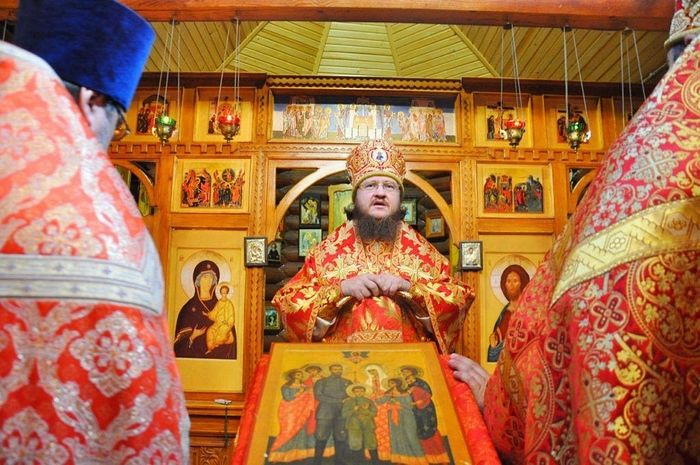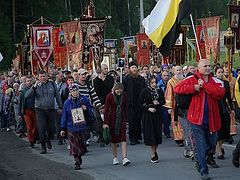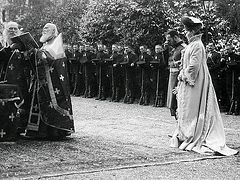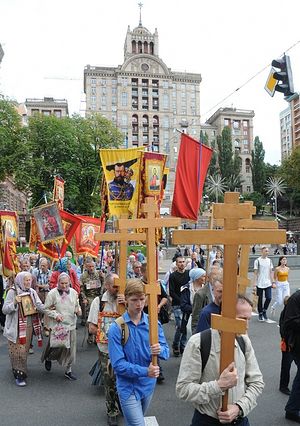 Cross procession on the day of the Royal Passion-Bearers on Maidan Square. Photo: Sergei Fritch On July 17, Orthodox Kiev, like many other cities throughout all of Ukraine prayerfully honored the memory of the Holy Royal Passion-bearers on the 101st anniversary of their martyrdom. On the night of July 17, Divine Liturgies were celebrated at the Holy Dormition Kiev Caves Lavra and at the Holy Trinity Monastery of St. Jonas, and festal services were held throughout most of the churches of the Ukrainian capital during the day.
Cross procession on the day of the Royal Passion-Bearers on Maidan Square. Photo: Sergei Fritch On July 17, Orthodox Kiev, like many other cities throughout all of Ukraine prayerfully honored the memory of the Holy Royal Passion-bearers on the 101st anniversary of their martyrdom. On the night of July 17, Divine Liturgies were celebrated at the Holy Dormition Kiev Caves Lavra and at the Holy Trinity Monastery of St. Jonas, and festal services were held throughout most of the churches of the Ukrainian capital during the day.
The traditional cross procession through the old district of Kiev also took place; it went from the walls of Kiev Caves Lavra to Holy Protection Monastery, founded by Grand Duchess Alexandra Petrovna Romanova, who received monasticism with the name Anastasia and became an Abbess, and is now glorified among the choir of the venerable[1] saints.
A correspondent of our the Pravoslavie.ru website visited the Kiev Church of the Royal Passion-bearers (on the territory of pediatric hospital № 1) on that day, and this is what he saw and heard there.
A Little History
To reach this small, cozy church at the City Pediatric Clinical Hospital № 1, located at the exit of Kiev in the direction of Vyshhorod, one would need to cross the entire city, which was once called the “Russian Jerusalem”, so beloved by the august family of Emperor Nicholas II.
The Royal family often visited Kiev and its ancient holy sites on the way to the Crimea; the Emperor himself visited the city on many occasions.
Thus, in 1911, he spent considerable time in the ancient city — first on the celebration of the 50th anniversary of the “great reform and emancipation of peasants”, and then to bid farewell to the assassinated Prime Minister Peter Stolypin, who was murdered by a terrorist, and buried beside the walls of the Refectory Church of Saints Anthony and Theodosius in the Kiev Caves Lavra.
The Tsar-Martyr prayed before the tomb of Prince Yaroslav the Wise, and at the relics of Holy Hierarch Makarios of Kiev in Saint Sophia Cathedral in Kiev during the First World War, and also visited the tomb of Grand Princess Alexandra Petrovna in Pokrovsky Monastery. In fact, the churches and many facilities of this famous monastery were, like many of the ancient churches of Kiev, built at the expense of significant funds from the royal treasury.
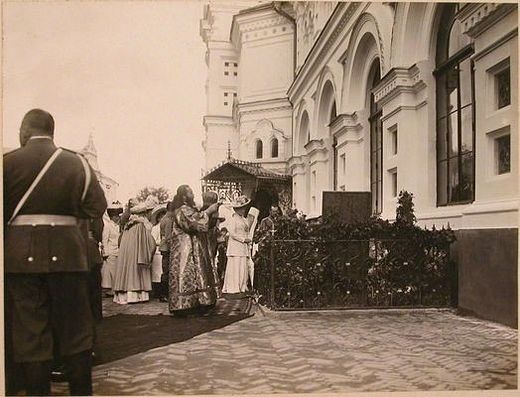 Emperor Nicholas II, Empress Alexandra Feodorovna, the Grand Duchesses, and priests at the Kiev Caves Lavra at the grave of Iskra and Kochubey, September 12, 1911.
Emperor Nicholas II, Empress Alexandra Feodorovna, the Grand Duchesses, and priests at the Kiev Caves Lavra at the grave of Iskra and Kochubey, September 12, 1911.
Nicholas II also loved to visit the caves of the Kiev Lavra. General Vladimir Fyodorovich, who accompanied him in those last years of his life wrote: “It was surprisingly beautiful: beneath the sound of all the Lavra’s bells, the Sovereign came to candlelit churches; along his way monks lined up in long black mantles, bowing low, almost to the ground unto their Tsar.”
In the Church of the Holy Passion-bearers on that day
 Moeleben at the Church of the Holy Royal Passion-Bearers
Moeleben at the Church of the Holy Royal Passion-Bearers
The Rector of the Church, Archpriest Andrei Pavlov met us. Here is what he had to say about the foundation of the church:
Our parish of the Ukrainian Orthodox Church in the name of the Holy Royal Passion-bearers was founded at the end of the year 2006, at the blessing of His Beatitude, Metropolitan Volodymyr of Kiev and All Ukraine († 2014). The creation of this church was inspired and initiated by one of the most well-respected and experienced priests of Kiev—the now reposed Archpriest Roman Kosovsky. († 2013). Our beloved Father Roman fell asleep in the ninety-first year of his life. It was he who gave the name to the future church.
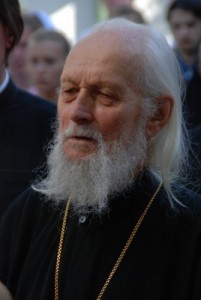 Archpriest Roman Kosovsky. († 2013) It happened like this: When we asked him: “In honor of which saint should our church be named?” Father, having thought for a while, answered: “In honor of the Holy Royal Martyrs”. Then we asked: “And why in their honor?” Father looked on affectionately, turning his gaze to the horizon, and replied: “Well, after all, the Tsar Family helped to care for the sick! And we have sick children here[2]…”
Archpriest Roman Kosovsky. († 2013) It happened like this: When we asked him: “In honor of which saint should our church be named?” Father, having thought for a while, answered: “In honor of the Holy Royal Martyrs”. Then we asked: “And why in their honor?” Father looked on affectionately, turning his gaze to the horizon, and replied: “Well, after all, the Tsar Family helped to care for the sick! And we have sick children here[2]…”
In truth, the Tsar family was famous for helping the poor, the needy, the suffering, and the sick. They helped both materially, physically, and spiritually. The eldest royal daughters, together with the Empress Alexandria, were sisters of mercy. We believe that the heavenly patrons of our church tirelessly help today, treating and healing in this hospital.
Father also chose the place for the construction of the future church. The first service was held on the feast day of the Holy Royal Martyrs on July 17, 2007, led by Archpriest Roman.
Soon the believers met Archbishop Feodosy (Snigirev), the archbishop of Boyarka and administrator of the northern vicarate of Kiev; they served as one the Akathist to the Holy Royal Family and the Divine Liturgy; practically the entire parish received Holy Communion. Archbishop Feodosy spoke in his sermon at the end of the liturgy to the crowded church about the martyric podvig of the Royal-Passion Bearers and the significance of Nicholas II in the history of [various—trans.] states[3]:
Nearly 20 years have passed since the glorification of the Royal Passion-bearers was celebrated throughout the Church. Many of you remember the preparation for the glorification. Voices even sounded in the church saying: “But where are the miracles testifying to the sanctity of the royal family?” In response, Orthodox people gave testimonies of thousands of miracles that occurred through the prayers of the Holy Tsar-Passion-Bearer Nicholas II and his pious Family. Miracles continue to this day. There is even an opinion that among the saints of these final times, the Royal Family are the saints who manifested the greatest number of miracles to modern people—our compatriots. Icons stream myrrh, people receive healing, strengthening in spiritual life and help in earthly life.
Why is the memory of the Royal Passion-bearers so holy for us, if not even only for the abundance of miracles?
At that time, more than 100 years ago, when the Holy Emperor was deceived into abdicating from the throne, and his family was expelled and mocked, the ruler of the nation was something different from now when states are headed by presidents and prime ministers. In those days, there were practically no nation-states like today. There were either empires or countries that were remnants of multi-national empires. Emperor Nicholas was the Emperor of a single, multi-million numbered nation, not divided into ethnic groups and national republics. The last months of the lives of the Royal Family, and especially their martyrdom, like a small flash, reflected the entire history of our Fatherland, when it was one. And then—to some extent, a brief story of independent republic states were formed on the ruins of the Russian Empire and in the Soviet Union.
We know that when the family was imprisoned in the Ipatiev House in Yekaterinburg, the commissars often had to change their guards, because seeing the piety, love, and meekness of these people, the guards became sympathetic towards them and could no longer treat them as prisoners.
The Bolsheviks knew this and regularly changed the guard. Shortly before the denouement, a certain Avdeyev, a former criminal, convicted four times for murder and bloody robbery, who hated all that was right, all the Orthodox, and everything connected with the Royal Family, was appointed as commandant.
Representatives of the international revolutionary forces were sent to the guard corps, who also hated Tsarist Russia and God's Anointed. And then this terrible murder followed ... How strongly did those final days of suffering resemble the following years and decades of contempt and the mocking attitude of the atheistic state towards the Orthodox Church, just as they treated Emperor Nicholas II himself!
Even to this day, we often experience this hostility towards us and our Church, we see this in the long-suffering Ukraine. After all, even now the spiritual descendants of those torturers continue the work of their fathers and grandfathers, although with other slogans. They also dislike our intercessors before God—the Holy Royal Passion-bearers, they also try to attract “democratic” international and foreign masters to fight the Church and all that remains of that pious time, when Orthodoxy determined the worldview of our nation.
But we do not lose hope in the mercy of God towards our nation, and we hope for its return to its Orthodox roots. We believe that the prayers of the Royal Passion-Bearers and all the martyrs and confessors of our land, who shed their blood in the twentieth century for Christ, will incline the mercy of the Lord to our land. And peace, prosperity, tranquility, and faith will reign amidst us.
The prophecies of the spiritual athletes of piety of the twentieth century will be fulfilled, and Orthodox churches built over the past decades will be full of worshipers. And a new century of pleasing God will begin, when Holy Rus’ will rise, and be that candle and lamp that shines to the whole world, which at the end of time will be a beacon for all mankind.
Let us ask this from God, with all our heart, that the cups of sorrows that the Passion-Bearers drank pass over us, and that we have entered a time when Orthodoxy will shine on our land with glory and honor, and no one will dare to say anything bad about the holy Royal Passion-Bearers or about our faith.
***
At the end of the holiday, the children gave a small performance in which they glorified the Royal Martyrs.

